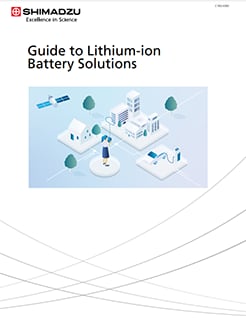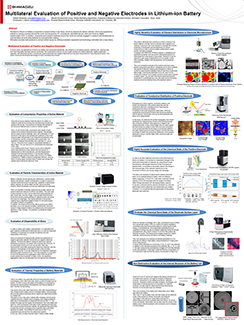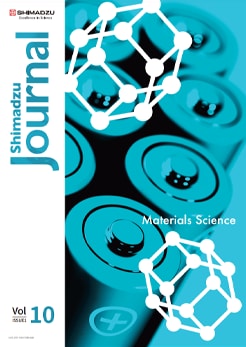Investigation of Thermal Properties of Lithium-Ion Battery Components
Batteries and Fuel Cells Testing and Inspection
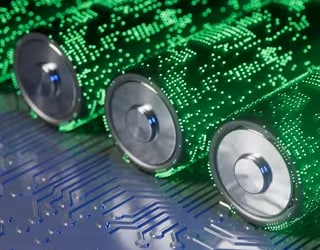
Testing, Analysis and Inspection of Batteries and Fuel Cells
Advances in fuel cell and battery technology are enabling the proliferation of electric vehicles. Shimadzu manufactures a complete range of instrumentation to characterize the composition and thermal/mechanical behavior of battery cell membrane, electrolytes and electrodes.
SALD-2300 Laser Diffraction Particle Size Analyzer - measurement of Lithium-Ion Battery Materials
Shimadzu's SMX-225CT scanners enable precise nondestructive imaging of internal battery components.
Shimadzu subsidiary Kratos Analytical offers X-ray Photoelectron Spectroscopy instruments for advanced surface and electrochemical investigations.
Guide to Lithium-ion Battery Solutions
Solutions for material testing, thermal analysis, organic / inorganic component analysis, internal structure evaluation, microanalysis, and particle characterization of lithium-ion batteries.
Multilateral Evaluation of Positive and Negative Electrodes in Lithium-ion Batteries
Demand for lithium ion batteries is expected to expand further in the future, driven by demand for electric vehicles, which are supported by policies in various countries around the world, and demand for PC, smartphone, and tablet devices, which are driven by digital transformation (DX). In addition, companies and research institutes around the world are actively engaged in research and development to commercialize all solid state batteries as next generation batteries. Shimadzu provides total solutions to various market issues by utilizing evaluation equipment and technology cultivated over a long history.
Shimadzu Journal - Vol.10 Issue1-Nov 2022 | Materials Science
This issue focuses on Materials Science particularly on lithium-ion batteries (LiBs). It starts with two customer interviews in which users discuss their relationship with Shimadzu. The first interview is with Dr. Sascha Nowak, head of the Analytics & Environment division of the MEET battery research center in Münster, Germany. In the second one, we talk with Mr. Keiji Sumiya from the Japanese chemical manufacturer Showa Denko Materials Co., Ltd.. In addition, we highlight four applications on analyzing LiBs from different angles using our latest technologies, and also present information on the latest news and topics.
Lithium-ion Rechargeable Battery Testing Instrument Matrix
| Part | Material | Commonly Used Components | Test Items (Instrument) |
|---|---|---|---|
| Positive Electrode | Active Material | LiCoO2 (lithium cobalt oxide) Mn or Ni may be used instead of Co. |
Composition (ICPES,ICPMS,XRF) Particle Size (Particle Size Analysis) Electron State (XPS) |
| Binder | Vinylidene fluoride (polyvinilidene fluoride (PVDF)) | Molecular weight distribution (GPC), Composition (FTIR) | |
| Negative Electrode | Active Material | Carbon, graphite | Particle Size (particle size analysis) |
| Trace Additive | Li, P, Cu, Na, Co, Ca, K, etc | Composition (ICP, ICPMS) | |
| Binder | SBR CMC(carboxymethylcellulose), PVDF also used previously |
Structure (FTIR) | |
| Separator | Polyolefins (high-density polyethylene) | Structure (FTIR) Thermal characteristics (TGA) |
|
| Electrolyte Solution | Solvent | Carbonate ester, carboxylate ester, ether | Composition (GCMS,GC) |
| Electrolyte | LiPF6, LiBF4 | Composition (ICP, ICPMS) | |
| Additive | Vinylene Carbonate | Composition (GCMS) | |
| Cells Single-cell, module |
Compression strength(Universal testing machine) | ||
Featured Applications
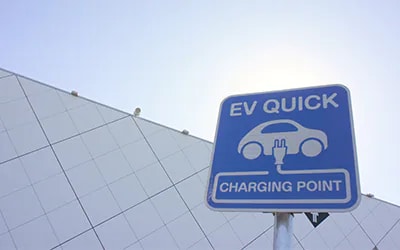
Positive Electrode
The positive electrode is an important component that influences the performance of lithium-ion battery. Material development is underway to improve the high energy density and durability against charge/discharge cycles. In order to reduce the cost of battery and ensure a stable supply, the flow of cobalt-free positive electrode active materials is advancing.
-
Thermal Properties (DSC, TMA, TGA)
-
Elemental Mapping (EPMA)
-
State Analysis (EPMA)
-
Element and Current Mapping Analysis (EPMA, SPM)
-
Compression Test (MCT)
-
Testing, Analysis and Inspection of Batteries and Fuel Cells
-
Anode and Cathode Air Exposure (SPM or AFM)
-
Non-Destructive Observation (X-Ray CT)
-
Particle Properties (SALD)
-

Negative Electrode
As the market for lithium-ion battery for automotive use expands, the challenge is to further improve energy density while reducing costs. As a component, the negative electrode plays an important role together with the positive electrode.
-
Compression Test for Anode Material (MCT)
-
Visualization of the Additive Layer (SPM)
-
Particle Properties (SALD)
-
Testing, Analysis and Inspection of Batteries and Fuel Cells
-
Anode and Cathode Air Exposure (SPM or AFM)
-
Non-Destructive Observation (X-Ray CT)
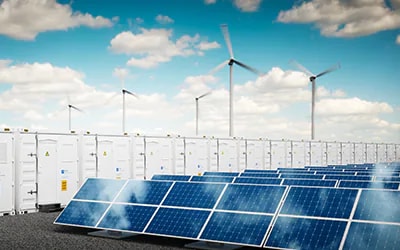
Separator
Separator is an important component that prevents short circuits between positive and negative electrodes, and at the same time facilitates the smooth passage of lithium ions. In addition to high safety, high energy density, high input/output, and low cost are required, and performance evaluation from various viewpoints is important.
-
Thermal Properties (DSC)
-
Thermal Properties (TMA)
-
Multifaceted Evaluation (X-Ray, CT, SPM, AG)
-
Piercing Test (AG)
-
Evaluation of Temperature-Dependent Strength Properties of Lithium-Ion Battery Separator by Piercing and Tensile Testing
Multi-Faceted Approach for Evaluating Lithium-Ion Battery Separators
-
Evaluation of Temperature-Dependent Strength Properties of Lithium-Ion Battery Separator by Piercing and Tensile Testing
-
Compression Test of Lithium Ion Battery Materials (MCT)
-
Non-Destructive Observation (X-Ray CT)
-
Visual Evaluation by Scanning Probe Microscope (SPM)

Electrolyte Solution
The electrolytes and solvents that make up the electrolyte solution must-have characteristics such as oxidation and reduction resistance during charge and discharge, thermal and chemical stability, and ionic conductivity, and must be capable of producing high-quality SEI coatings. It is also important to analyze electrolyte solution components in order to evaluate battery performance because the composition is modified by battery reaction.
-
Glove Box System (FTIR)
-
Deterioration Evaluation (IC)
-
Deterioration Evaluation (GCMS)
-
Organic Component Analysis (GCMS)

Battery Cell
Lithium-ion battery are used in a variety of fields and applications, and it is important to analyze defective products, compare good products and defective products, compare before and after charging and discharging, observe structural changes inside cells in cycle tests, and evaluate gas components.
-
Non-Destructive Observation (X-Ray CT)
-
Internal Gas Analysis (GCMS)
-
In-situ Microfocus X-ray CT Investigation of Charge/Discharge Effects in Cylindrical Lithium-ion Batteries
-
Analysis of Gas Generated from Lithium Ion Rechargeable Battery Cells
-
Analysis System for Internal Gas (GC)
-
Simultaneous Analysis of Evolved Gas (GC)
Journals & Papers
Experimental study on the formability of aluminum pouch for lithium polymer battery by manufacturing processes
Yu, M., Song, M., Kim, M. et al. J Mech Sci Technol (2019) 33: 4353. https://doi.org/10.1007/s12206-019-0831-y





